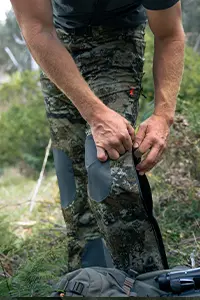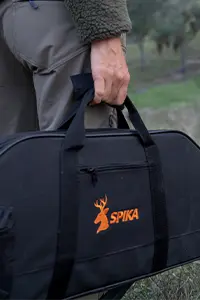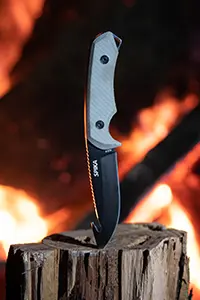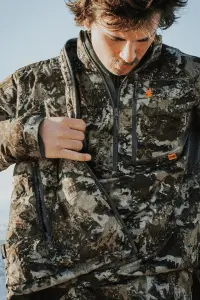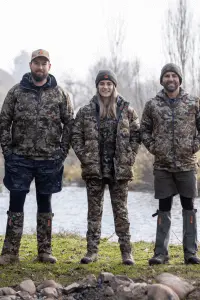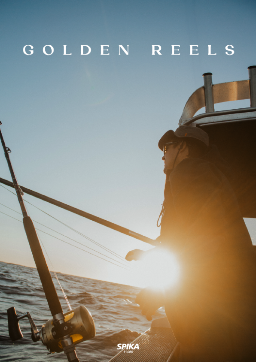ZAMBERLAN BOOT CARE GUIDE
How To Correctly Look After Your Zamberlan Hunting Boots
Knowing how to correctly clean your hunting boots is very important for anyone who owns a pair. Looking after your boots the right way allows the technical qualities to last longer. That’s why you need to follow these steps.
After a few days of trekking our shoes need to be treated in the right way to avoid ruining them. Taking care of hunting boots means, first of all, keeping the technical qualities that made us choose the boot intact, so as to prolong their durability over time.
Just think of the stress to which the boots are exposed to during our excursions: for example, often we pass from damp and muddy soils to rocky surfaces and it is natural therefore that dirt and debris of various kinds can get into the sole rather than leaving obvious marks on the upper or other parts of the shoe. It’s a good idea to start by cleaning the soles before proceeding with the rest of the boots so remove stones or residue from under the shoe, possibly using a brush.
What are the right steps to take when cleaning Zamberlan boots?
The first thing to do, before starting to clean your Zamberlan boots, is to remove the laces (fig.1). At this point we can start: the trekking boots must be washed under a jet of cold water (fig.2). If necessary, when they are very dirty, it is possible to use a gentle or neutral soap to make cleaning easier.
What are the right steps to take when cleaning Zamberlan boots?
The first thing to do, before starting to clean your Zamberlan boots, is to remove the laces (fig.1). At this point we can start: the trekking boots must be washed under a jet of cold water (fig.2). If necessary, when they are very dirty, it is possible to use a gentle or neutral soap to make cleaning easier.
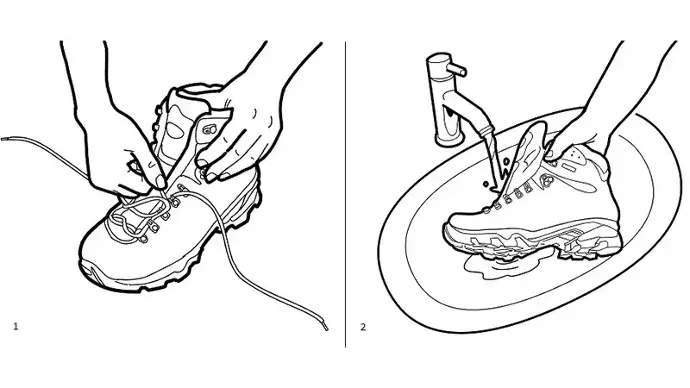
Fig.3 and fig.4 refer to the drying of shoes: it is essential to remove the insoles and leave the shoes to dry in a cool and ventilated area. ATTENTION: never put them in direct contact with sources of heat such as fires, radiators, electric heaters or boilers, which could lead to the breaking or shrinking of the leather, damage the adhesion of the sole to the upper or could cause detachment of the rubber protection tip. If Zamberlan hiking boots are dried by exposure to heat sources and damaged, the warranty is no longer valid. The best thing to do is to let the trekking boots air-dry, avoiding direct sunlight. To maintain the shape during drying it is advisable to insert some newspaper into the shoe. Once dry, mountain boots must be treated in the right way.
This means taking care of the upper to prevent it from getting ruined and to extend its durability over time
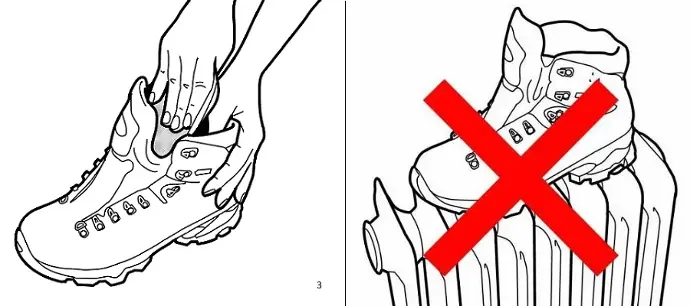
If it is in full grain leather (fig.5A-1 and Fig. 5A-2) then it is advisable to apply the Zamberlan® Hydrobloc® Cream directly on the surface of the shoe, which must be clean and dry, and distribute it on the surface with help from a soft brush. It is essential to use technical products for the maintenance of mountain boots because oils and natural fats nourish the leather well, but if overused they could make the upper too soft and deformable and these shoes must also remain very resistant. Finally, before using them again, it is good to let them rest for a few hours to allow for proper absorption of the products used and then they can be polished.
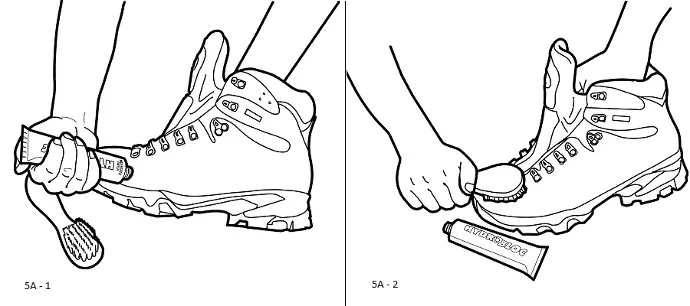
If the upper is in Nubuck leather, split leather, Nubuck and fabric or a mixture of suede and fabric (fig.5B), then the best product to use is the Hydrobloc® Zamberlan® Spray Balm. After shaking it well, apply two layers on the clean and dry upper, spraying from a distance of about 20 cm and waiting about 5 minutes between the first and second application. Also, in this case, before wearing them, leave the shoes to rest for a few hours.
A further possibility is that mountain boots are made with a leather lining. In this case (fig.6) it is advisable to clean the lining with a damp cloth, let it dry and then apply a light layer of Hydrobloc® Cream or Spray which nourishes the leather keeping it soft and supple. Use the boots only after letting them rest for a few hours.
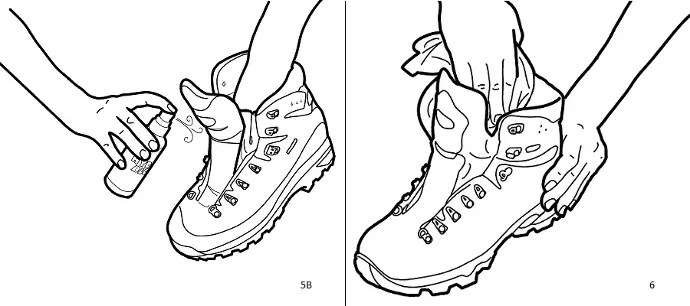
Other useful tips for the maintenance of mountain boots
Check laces: in shoe maintenance, laces are not a secondary element. These components usually last a long time, but over time they can wear and break. For this reason it is important to keep them checked. It is possible to use different laces from those proposed by Zamberlan®, but remember that they must comply with the GORE-TEX® requirements, in order to guarantee the waterproofness of the boot. It is always advisable to have a pair of replacement laces on excursions, especially in remote areas. Zamberlan® offers different types of laces as replacement parts for substitution when necessary.
Synthetic inner lining: it doesn't require any special attention; simply use a warm, damp cloth after every use, wash and leave out to dry.
Leather lining: these types of linings offer a special comfort, but must be treated regularly to maintain their characteristics. Sweat from the feet can in fact damage or modify the acidity. For this reason, we recommend cleaning the lining with a warm and damp cloth, then letting it dry. Finally apply a thin layer of Hydrobloc® Zamberlan® cream or spray.
Sole: the soles must be monitored over time; it is important after a hike to check that no stones have got stuck under the soles and if there are any then do remove them. This prevents damage to the sole caps. Over time and with use the sole gets consumed; excessive wear to the tread can compromise your safety. Most soles on Zamberlan® models can be replaced. You can find out if the sole can be replaced by visiting the product web page and verifying the presence of the appropriate logo:
Footbeds: the insoles should be cleaned regularly and, according to regular use of footwear, it would be advisable to change them once every 6 months or at least once a year. Zamberlan® offers different types of replacement according to your needs.
Remove odours: to combat bad and unpleasant odours of mountain boots, the secret is to use talcum powder or sodium bicarbonate. Do be careful not to do it too often and remember that a small amount is sufficient.
Where to store hiking boots: if you want to uphold the quality of the leather and the correct shape, you must keep them in a place with normal and constant temperature (around 18-20 °C). Avoid places that are too cold or too hot for long periods of time and make sure the shoes are always fastened so that the shoe is in the correct position.
Detailed Care Instructions:
Preliminary Care: Cleaning & Drying
Cleaning: To begin, remove the laces and wash the boots under cold tap water, using a mild soap (not a detergent!) if you wish. Ensure that all debris is removed from the uppers and soles. Rinse the boots well, especially if they have been exposed to peat, as its acidity can be particularly destructive.
Drying:
Remove the footbeds and leave everything to dry slowly and thoroughly in a cool to a warm, well-ventilated area. If the boots are very wet it may be advisable to stuff each boot with newspaper during the drying process, replacing as required. Be sure NOT to attempt to accelerate the drying process by placing the boots near direct heat sources such as fires, radiators, fan heaters, or boilers, as this will cause cracking and/or shrinkage of the leather and may seriously damage the bonding compounds used in the construction of the boot. Again, NO HEAT!
Uppers: Proofing & Conditioning
Introduction: Appropriate proofing and conditioning vary according to the materials used for the uppers of your boots, but in every case, its main function is to feed the leather with the correct degree of support and suppleness, as well as to maximize its water resistance. For boots with composite leather/fabric uppers, the treatment will also help maintain the water resistance and repellency of the fabric sections.
How often treatment will be required depends upon, amongst other things, the terrain and conditions in which the boots are used and the frequency of their use. As a general guide, it is better that you proof and condition the boots on the 'little and often' principle, rather than applying excess quantities of treatment on an infrequent basis. Before long periods of storage, treatment should be applied, as significant drying may occur if left untreated.
Please note, if you decide to use treatments other than Zamberlan Hydrobloc leather treatments, they should meet the requirements in place for Gore-Tex (if applicable). This means no silicone-based treatments or any treatment that will (a) clog the pores of the Gore-Tex membranes, or (b) block the leather's natural ability to breathe. There are several providers in the market that make excellent products. Please contact info@zamberlanusa.com for further information.
Full Grain Leather:
When the uppers are fully dry, apply Zamberlan Hydrobloc Cream sparingly; use a soft brush to apply the treatment, working it thoroughly into the leather. Leave to cure overnight before use, after which you may wish to buff your boots to a shine as excess surface proofing will attract particles of grit or sand that can abrade the leather when the boot is flexed. We recommend that you test the product on a small area initially, as darkening of the leather may occur. Here is a step-by-step video guide for full-grain leather:
Nubuck Leather, Nubuck Leather/Fabric, Split Leather/Fabric:
Zamberlan Hydrobloc conditioning spray should be applied when the boots are dry and clean. Shake the container well and apply 2 coats of conditioner to the whole of the upper (including the fabric sections where present) from a distance of approximately 20 cm, allowing 5 minutes between coats (to let the conditioner soak in). Wipe any excess conditioner from soles and the sole/upper junction, and leave to dry overnight before use. We recommend that you test the product on a small area initially, as darkening of the leather may occur after application. Here is a step-by-step video guide for split-grain, suede, and nubuck leathers:
Linings-Care, Proofing and Conditioning.
Zamberlan boots may be lined with Cambrelle, Gore-Tex, leather, mesh or a combination of these materials. Man-Made Linings: These do not require special care; they simply need to be allowed to dry naturally and thoroughly after use and cleaned with a warm damp cloth from time to time. Leather Linings: Leather linings do however need to be regularly cared for to maintain their performance. Whilst offering superb comfort, leather can become damaged, dried and cracked by the acidity of the feet's perspiration. For this reason, you should regularly clean the leather linings with a warm damp cloth, allow to thoroughly dry, and then apply a thin coat Hydrobloc Proofing Cream or Hydrobloc Conditioning Spray which will feed the leather, keeping it soft and supple.
Soles: Inspection, Care & Resoling
The soles do not generally require any special attention, but it is good practice to regularly inspect them for wear and general condition. Pay particular attention to any stones which might have become lodged in the sole, removing them carefully prior to subsequent use. Failure to do so may result in damage to the sole unit. Check the depth of tread from time to time, as security and safety may be compromised by a significantly worn sole. Most Zamberlan boots are able to be resoled by specialist cobblers. If your Zamberlan boot was Made in Italy, it can always be resoled. You can see a list of Zamberlan USA-approved cobblers on our website in the Help Center.
Laces and Footbeds: Inspection, Care & Replacement
Laces will normally offer a fairly long service life, but cannot be expected to last indefinitely. Check regularly for signs of wear, replacing with genuine Zamberlan laces as and when necessary. After-market laces can also be used so long as they meet Gore-Tex requirements for moisture-wicking and are considered suitable for the stresses of outdoor use. It is a sensible precaution to carry a spare set at all times, especially when walking in remote areas.
The anatomic footbeds supplied with your boots should be regularly cleaned and replaced from time to time with genuine Zamberlan footbeds. If you use your boots regularly you should consider replacement every six to twelve months. There are suitable after-market footbeds also available at specialist retailers around the country.
Do’s and Don’ts When Caring For Your Hunting Boots
Please note, there are some cardinal rules of boot care that everyone must follow. Not following these rules will not only lead to incurable damage to your boots but will invalidate your warranty. Here are the cardinal rules:
Rule #1: Never put your boots near a heat source
If boots are placed near a source of heat, like a fireplace, heat register, or even under a blast of hot air from a vehicle heater, the leather can dry out to a point from which it cannot recover, causing shrinkage and wrinkling. This change in the leather leads to delamination of rubber rands and even potential sole delamination. (Delamination here simply means a separating of two components held together by boot cement.)
If your leather boots are wet on the outside do not worry, this is the primary purpose of hiking boots - to protect you from the elements! Outdoor wetness is completely normal and fine. Simply let the boots dry naturally in open air and they will be fine. Once every few months use a quality leather conditioner approved for use with Gore-Tex membranes and ensure a proper level of hydration (not too much, not too little). Please also be careful of leather conditioners that contain chemicals which can delaminate the cement used to attach rubber rands to leather uppers (select models only). We recommend Hydrobloc Spray (split grains and nubucks) or Hydrobloc Cream (full grains).
If you step into a deep stream or experience heavy rain and the insides of your boots become wet, do not use heat to dry them out on the inside. Instead, use (a) the open air to naturally dry with time, (b) newspaper, which acts as a sort of sponge absorbing moisture, or (c) a Peet boot dryer, which uses room temperature air to dry the boots more quickly. Do not let the boots sit long without addressing moisture inside of the boot as this may allow for the formation of mold. The same can be said of excessive foot moisture caused by sweating, especially with leather-lined boots. This is the primary rule of leather boot care!
Rule #2: Do not use a leather conditioner that is not approved for use with Gore-Tex membranes
Gore-Tex membranes require that a specific type of leather treatment be used on the boot. Silicone-based and other non-approved treatments can clog the pores of the membrane, which will cause them to stop breathing and will also invalidate your Gore-Tex warranty. We recommend using our Hydrobloc cream (full grains) or spray (nubucks, split grains and Perwangers) or another product on the market approved for use with Gore-Tex (e.g. Nikwax).
Please also be careful not to use leather conditioners known to delaminate the cement used to attach rubber rands to leather uppers. While excellent for the life of your leather, delamination of a rubber rand can be difficult to cure.
Rule #3: Buy the right boot or shoe for the activity
Zamberlan strongly recommends buying boots and shoes that are well suited for the intended purpose and the intended environment. While this seems obvious, it is not always readily apparent when evaluating different models. There are specific reasons why Zamberlan offers many different models of product within the same category, and that is because usage varies greatly depending on the user and the geography in which the activity is being enjoyed.
For example, customers selecting a backpacking boot to be primarily used in the backcountry will want a supportive model with approximately a 4.0mm insole. If the backpacker plans on navigating rough backcountry areas with tough rock or shale, we strongly recommend buying a more rugged boot employing a full rubber rand (e.g. the 960 Guide GTX RR). Likewise, a thru hiker on the Appalachian Trail (or similar) should shy away from unsupportive "running-style" shoes which will not last the journey and ultimately lead to injury due to over-fatigued feet. Proper structure, support, and insole stiffness exist for a reason, which is to transfer workload from the foot to the shoe.
Selecting the wrong boot for the activity not only affects user experience and performance but the product and hiker durability as well.
JOIN TEAM SPIKA AND GET UPDATES FOR THE BEST HUNTING GEAR AND NEW RELEASES. SIGN UP



